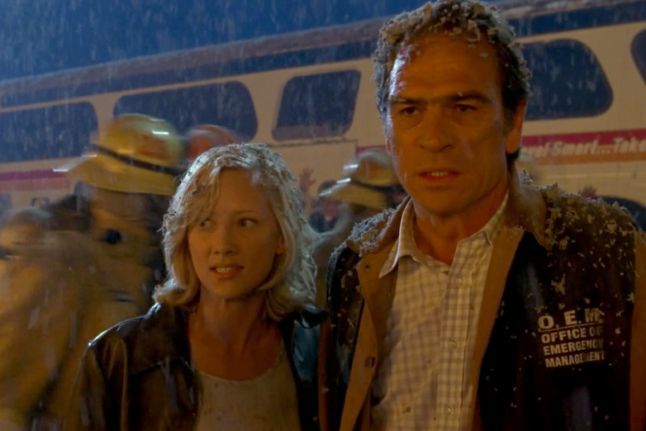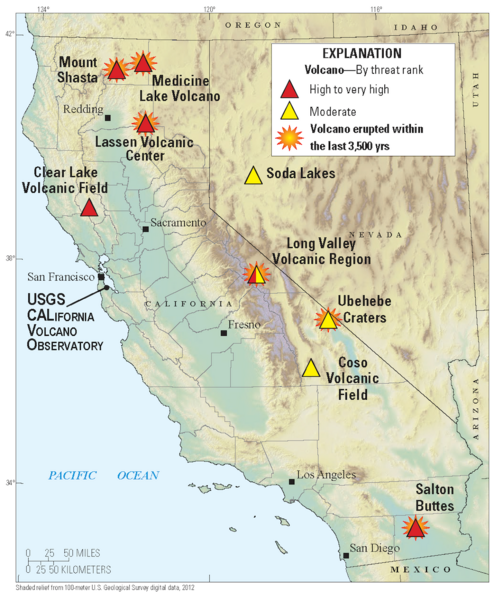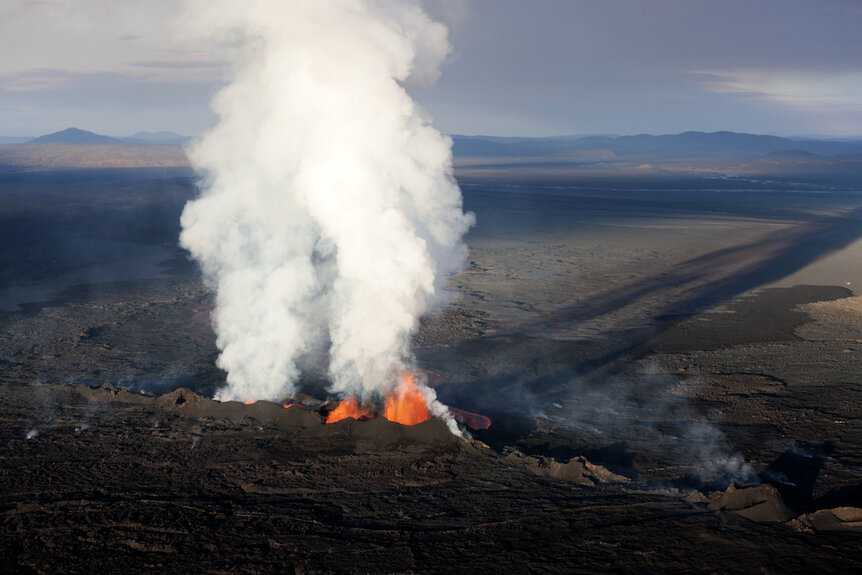Create a free profile to get unlimited access to exclusive videos, sweepstakes, and more!
Lava in Los Angeles: The science behind 'Volcano'
Any time Tommy Lee Jones shows up, it's probably best to just walk in the other direction.

Before Moonfall and Don't Look Up, there were the disaster films of the '90s. They always seemed to come in pairs. Dante's Peak gave audiences two hours of Pierce Brosnan against a tectonic inferno, and a few months later Fox followed up with their own volcano movie, appropriately called Volcano.
What starts as an earthquake in downtown Los Angeles quickly ramps up when it's realized that the shakeup was only a precursor to a deadlier disaster; a killer volcano is forming beneath the streets of L.A. What follows is a mad dash against time and the environment to redirect the volcanic flow and save lives before the city is swept away by a wave of lava.
We could dismiss the events of the movie as nothing more than silver screen entertainment, and it certainly was that, but that would be too easy. Let's settle the question, once and for all. Is Volcano lying or is it legit?
COULD A VOLCANO ERUPT IN L.A.?
California has plenty of tectonic activity, the state is sort of famous for that kind of thing, but earthquakes are much more common than lava flows. The California Volcano Observatory lists fifteen areas of volcanic activity, ranging from low to very high. Of those, several areas have had eruptions in the last 3,500 years. Geologically speaking, that's pretty recent, but it's a while on human timescales. More importantly, none of them are all that close to Los Angeles. The nearest volcanic area is the Coso Volcanic Field, about 181 miles away.
That said, volcanic activity can crop up anywhere there's a tectonic fault. The San Andreas fault — the largest fault line in the contiguous United States — runs for about 750 miles right through California, stopping a mere 35 miles outside of Los Angeles.
A smaller fault, known as the Wilmington Blind-Thrust fault, runs from Huntington Beach toward the Santa Monica Bay, cutting right beneath Los Angeles harbor. It's long been thought to be dormant and so an unlikely candidate for earthquakes or volcanoes, but recent research indicates that might not be the case.
While there are faults in an around Los Angeles, that might not be enough to birth a volcano. Faults are essentially cracks in the Earth's surface but in order for a volcano to occur, there also needs to be a source of magma. Those most commonly occur where one plate subducts — slides under — another. The San Andreas fault is a strike-slip fault, in which the two plates slide past one another. Wilmington is a blind-thrust, meaning one plate slide up and over the other, but it doesn't break through to the surface.
All things considered, a volcano popping up in L.A. isn't impossible, but it's incredibly unlikely. Just for funsies, though, let's pretend that it isn't and look at Volcano a little more closely.
TOXIC GASES
As the volcano progresses through the city, it's traveling largely underground through subsurface rail lines. At one point, passengers on a subway train fall unconscious owing to the heat and toxic gases from the flowing lava.
A quick aside: The distinction between magma and lava is based on location. When molten rock is underground, it's magma. Above the surface, it's lava. If molten rock has broken into an underground subway line, is it lava or is it still magma? The world may never know. Anyway.
Molten rock is host to all sorts of super fun heated gases which contribute to its violent explosion onto the Earth's surface. Lava can carry comparatively high concentrations of carbon dioxide that are released during an eruption. If CO2 levels exceed 15 percent of the total air, it can cause unconsciousness and death. Sulfur dioxide, hydrogen sulfide, and hydrogen halides can all come pouring out of lava flows and can cause respiratory distress and pulmonary edema. Exposure to too much for too long can absolutely be deadly.
Luckily, in most cases, these gases dissipate in the air pretty quickly. So, as long as you're not too close to the eruption, you're likely to be alright. If you happen to have the bad luck of being inside a subway car while molten rock is filling up the tube, then there wouldn't be anywhere for the gases to go.
This one is a check in the accuracy column. Those poor unnamed characters populating the movie's midpoint would be in some serious trouble if they weren't evacuated quickly.
VANISHING IN LAVA
There's one scene in Volcano which rises above all the rest. Even if you only ever caught the flick on late-night TV, you'll probably remember this particular scene until you return to ashes yourself. During the rescue mission inside the subway, a rescuer called Stan goes looking for the train operator and finds him unconscious. Heroically carrying the driver, Stan reaches the train's exit only the find that the lava has made its way beneath the car and is just now beginning to flow beneath his feet. Safety is a single leap away, but he can't make it while carrying the train operator.
Selflessly — or foolishly, we'll let history decide — Stan leaps from the back of the train, lands feet first in the lava, and tosses the driver to safety. By the time the camera jumps back to him, he's hip deep in molten rock. The next time we see him… well, we don't see him. He's vanished into the lava. It's dramatic, but is it realistic?
In a word: no.
This is a little counterintuitive because lava is liquid, and we tend to associate all liquids with the one we encounter most often. But lava is not water, its characteristics are vasty different. Most importantly, it's about three times denser than water and because humans are mostly made of water, you literally couldn't sink in even the deepest pit of lava. Instead, you'd just sort of sit on the surface, rapidly burning.
What might happen, depending on the behavior of the lava, is the introduction of your body might trigger a violent cascade of gaseous activity, not unlike dropping a mentos into a bottle of soda. The bubbling could envelop you, but not because you're sinking.
If you're thinking that Stan didn't sink, he simply burned up, that explanation doesn't fly either. The average temperature of lava is about on par with the temperatures inside a cremation oven and it takes hours to burn up a body.
This is just one of those cases where reality took a back seat so something could look cool. We're just going to have to be okay with that.




























